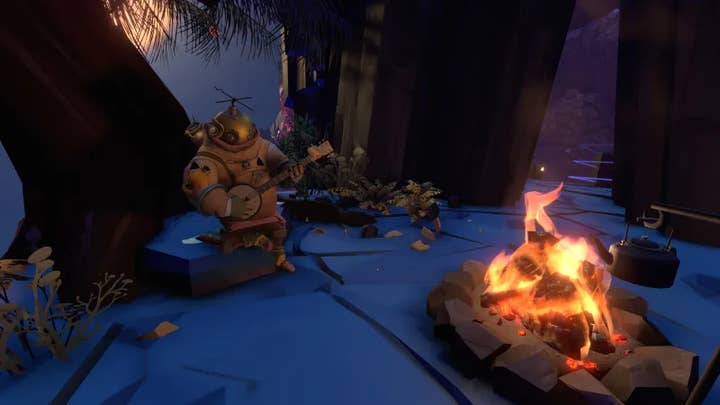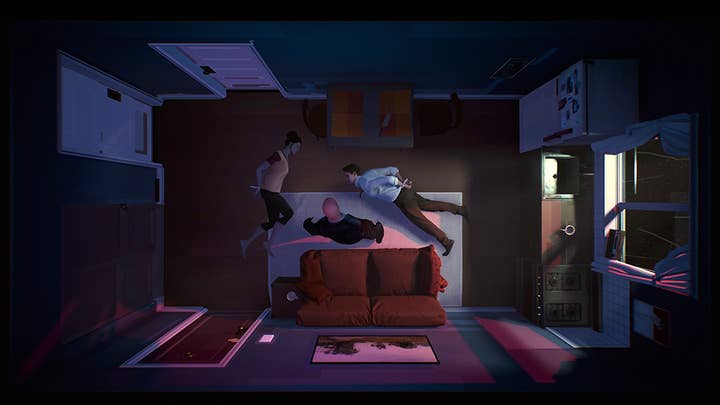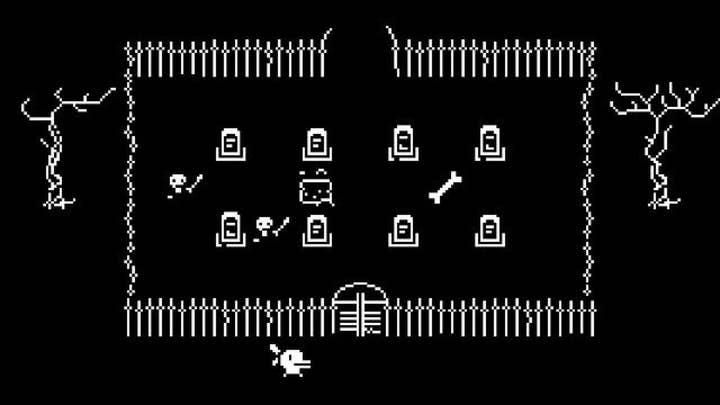Learn, reset, repeat: The intricacy of time loop games
We speak to the minds behind Twelve Minutes, Outer Wilds, Minit and more about the possibilities of this complex mechanic
The games industry has developed a fascination with a very particular form of time travel.
At E3, Annapurna Interactive and Bethesda announced Twelve Minutes and Deathloop respectively, both centred around playing through the same series of events over and over again.
Their unveilings follow hot on the heels of indie hit Outer Wilds, which traps players in a time loop as they explore the death of the universe. Last year, we saw 60-second RPG Minit and the year before that, Tequila Works released time-looped murder mystery The Sexy Brutale -- and is currently working on a Groundhog Day VR title, Like Father Like Son.
So why has this become a trend? Twelve Minutes developer Luis Antonio suggests it's almost certainly a coincidence -- "It happens with movies a lot" -- but observes that time loops share the inherent structure of video games. Die and you have to repeat the same section, this time with the accumulated knowledge of your previous experience to help you progress.

Minit co-developer Jan Willem Nijman suggests something deeper. Time limits, he says, can be stressful and with so many people leading stressful lives, this may be "leaking into art."
"It's a relatable feeling," he says. "Also, games are more diverse and exciting than ever. It makes sense that multiple creators are exploring the same kinds of ideas at the same time."
Alex Beachum, creative director at Outer Wilds developer Mobius Digital, adds: "As with any creative endeavor, many people independently felt a void that needed filling in the industry. There are a lot of unique types of games you can make using the idea of a time loop, and it's exciting to see all of the crazy experiments people are trying to take advantage of the idea.
"There also seems to be a collective desire to step back from the massive open-world arms race and refocus on narrow-but-deep approaches to world design. Playing with time as another axis of exploration definitely fits within that goal, so that could contribute to the increase in games that use a time loop."
The story of how each developer came to work on time loops differs. Antonio was fascinated by the concept, and wanted to explore how players could use their accumulated knowledge to affect elements in the game -- not just objects, but also characters and their relationships with them. Meanwhile, Nijman says the Minit team "wanted to make a game where no matter what direction you head in, there's always a unique one-minute adventure waiting for you."
"There seems to be a collective desire to step back from the massive open-world arms race and refocus on narrow-but-deep approaches to world design"
Alex Beachum, Mobius Digital
Outer Wilds' time loop was born out of the team's desire to make a game where the environment changed over time. Since some of Outer Wilds' changes are irreversible, a time loop was necessary to ensure players could explore things they might have missed.
The Sexy Brutale was openly inspired by Majora's Mask (at least in terms of the time mechanic), while the Groundhog Day IP means having a time loop in the VR follow-up was "a must."
"Actually, if you think the movie through, it is just like a narrative game, where the main character progresses unlocking new areas or scenarios as Phil Connors learns more information, and so we did for our game," says lead gameplay designer Alejo Silos. "We treated this time loop structure as a narrative metroidvania."
Tequila Works' CEO Raul Rubio says the mechanic empowers the player to "go wild," adding: "You can try to convince someone that you are trapped in a time loop. You can be a selfish jerk. You can eat someone's food while talking to them. It's all a way to express yourself, and the story resets each time."
The limit of time loops can vary wildly -- from Outer Wilds' 22-minute runs to Minit's, er, minute -- but finding the sweet spot has been one of the biggest challenges from these developers. In fact, Outer Wilds was originally built around 18-minute loops in its alpha form, but playtesting found that a little more time was needed to comfortably explore the more elaborate levels like Brittle Hollow or the Hourglass Twins.

"We wanted to keep things short enough [that] failure and death did not feel frustrating," explains designer and producer Loan Verneau. "But we also didn't want the player to feel like they were constantly on a time limit."
At the other end of the end of the spectrum, Nijman says the Minit team found 60 seconds to be "short enough to keep things low pressure" but does add a little tension. A maze might be simple, but with a ticking clock it becomes more intense.
"The longer the loop is, the harder it is for the player to understand the consequences of their actions"
Luis Antonio, Twelve Minutes developer
"Players are never punished for something they've messed up way earlier, and at most they'll have to replay one minute of progress," he says. "It's really at the core of Minit that we don't waste people's time, there's no recycled content or extensive backtracking, and people won't be forced to do the same things over and over again. And 60 seconds seems long enough to go on a proper little journey - it's more time than you might think."
Antonio spent a long time boiling down his concept to what would eventually become Twelve Minutes. At first, the loop was longer and players explored a whole city, but eventually this became a shorter experience in a single apartment.
"The longer the loop is, the harder it is for the player to understand the consequences of their actions," he explains. "Also, it could easily get very boring. Imagine you have a one-hour loop and you have to do a series of five or six events, and then you miss event number five and have to do it all over again... The more I [reduced it], the less handholding I had to do -- I realised I didn't even have to give the player an objective or guide them on anything."
He adds that success and failure become grey areas in a time loop. He offers the example of a cop entering the apartment; try to kill him and you'll die. It's a failure, but you learn attacking him doesn't work. Let him torture you (which could also be viewed as a failure) and you learn more about his motives -- knowledge you can use to your advantage later.

Nevertheless, there is always the danger of making a time loop repetitive or labourious to navigate. Charles Griffiths -- design director at The Sexy Brutale developer Cavalier Game Studios -- warns that: "Everyone loves the idea of them, but when you think it through in practice there are things that are inherent to a loop that run completely against what we consider to be good design."
With Brutale, Cavalier kept things simple: a nine-minute loop, split into three three-minute sections. Griffiths says the player is never more than two-and-a-half minutes away from something they can see or do, and they soon learn they can't save every murder victim in a single loop. This eases the pressure and allows them to focus on a single thread.
Similarly, Antonio says the apartment setting means everything they need is within 30 seconds' reach. In fact, Twelve Minutes has a series of mechanics that let you manipulate the loop how you see fit: sleep in the bed and time will accelerate, or leave the apartment and the loop resets. If players feel they have made a mistake, they can quickly get back to the scenario they want to try again.
Mobius' art director Wesley Martin says Outer Wilds was designed around four or five major questions, such as 'Where did the Nomai come from?' or 'Why am I in a time loop?'. All the locations players can discover help to answer these questions, or hint at other locations where they might find more clues.
"So whether players are just wandering or they are trying to answer a question they have, the content they find always hints at a possible way forward, often on another planet altogether," he says. "In many ways, the reset rarely impacts their progress as players can then go explore that new place they heard about from the previous loop."
Recording that progress can be something of a debate among developers. Outer Wilds uses a ship's log that maps out what you have learned, allowing players to identify loose ends they might want to explore. Similarly, Groundhog Day gives you a journal that offers tasks and hints, as well as characters with ideas on what the player might want to 'fix' during their current loop.

Twelve Minutes goes a different direction, with Antonio saying he has actively avoided signifying what events occur and when during each loop. Doing so, he says, "loses some of the ownership of you experiencing the loop, because you're just unlocking things."

Naturally, there are significant hurdles in designing games around a time loop. Having a set course of events introduces limitations, and enabling players to change those events can create so many variables it can be hard to account for them. The more open your time-looped world, the harder it is to know where the player might go and design the game in a way that ensures they always find something to do.
Silos offers Groundhog Day as a prime example -- the game has more than 300 flags and variables just to track what the player has and hasn't done, and doing so is vital when convincing players they have an effect on this world.
"Did they phone this person in the morning? Have they found about this key information? Did they break the window in this loop? Did they do X but not Y? Taking into account all these permutations made levels and characters a lot more believable and reactionary reinforcing the players' presence and immersion, which is the most important goal to achieve in a VR game."
"Time loops allow players to train to get better at the game, faster, smarter, by experimenting from a fixed starting situation"
Raul Rubio, Tequila Works
Griffiths, meanwhile, points to the intricacies of Sexy Brutale's loop. There are multiple characters moving through a myriad of encounters throughout the mansion in each loop, and Cavalier was determined to be consistent.
"We decided we were not going to cheat at all, so no character was allowed to go around a corner and then be teleported somewhere else to be used in another puzzle, for example," he says. "If they were going somewhere, they had to actually go there and have that be a 100% true part of the day's choreography. So all this meant that every single puzzle became dependent on every other puzzle in the game."
The art director once asked to improve the visuals of a room by moving a door a few inches to the right -- but this meant a character would take an extra second to cross the room, causing a chain reaction that would prevent or disrupt other interactions throughout the nine minutes. So the door had to stay.
"We had the entire map of the house and all the characters' movements, key events, timestamps, etc. mapped across an entire wall of the office using bits of paper and string," says Griffiths. "It was basically Charlie's conspiracy wall in Always Sunny in Philadelphia. That map was probably our finest work."

Beachum adds that this complexity "naturally leads players to develop hypotheses" as they explore how much of an impact they have on the loop and its events. He says that the first time some players saw Outer Wilds' sun go into supernova, they incorrectly assumed it was the result of their actions, prompting them to revisit whatever it was they did to see if it could be prevented.
"One unexpected side-effect of the time loop is how it breaks up the game in easily digestible chunks," he adds. "Because everything in the game can be done in less than 20 minutes, you never lose too much progress."
Silos notes that this is perhaps the greatest advantage of designing around a time loop: since players know everything will reset and their actions may not be permanent, "they are encouraged to explore and experiment as much as they want to."
Rubio concludes: "Time loops allow players to train to get better at the game, faster, smarter, by experimenting from a fixed starting situation, and seeing what it works to move 'forward' within the loop and adding something else to that structure to build a solid process.
"Paying attention to the details and detouring from the known path is the way players go beyond the initial boundaries of this jail in time and space and start grinding the loops to gain access to new locations, events and characters. You can think of time loops as metapuzzles where you play not only against the world but against yourself."








